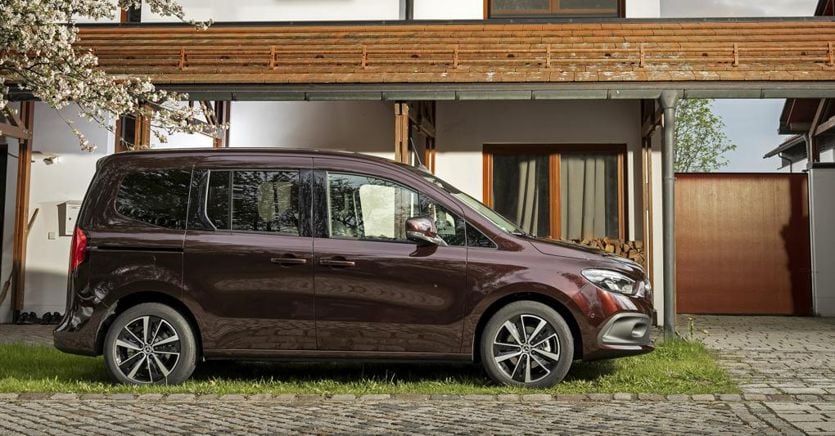MUNICH – By now the road of minivans is marked and, rather than with cars, they will be contiguous with commercial vehicles, but they may also have premium ambitions. This is demonstrated by the new Mercedes T-Class which, obviously, is a close relative of the Citan Tourer, but offers a level of finish, comfort and safety comparable to cars with the Star.
Franco-Japanese geniuses
After all, Mercedes has already done so with Vito and V-Class and today replicates this operation with the T-Class which, as is known, is the result of a joint project with Renault and Nissan which has also given birth, respectively, to Kangoo and Townstar, all built in the Auberge French factory. The T-Class is 4.5 meters long and 1.86 wide with a wheelbase of 2.72 meters and a height of 1.81 meters. Therefore its aesthetic character, although pleasant and well connected, is definitely oriented towards space and practicality. The rear side doors are in fact sliding with an opening of 61 cm and 1.06 meters, allowing a very comfortable access to the 60/40 rear bench seat in order to have a trunk that can be modulated between 520 and 2,127 liters, obtaining always and in any case a regular and practical compartment.
Loading is a snap
Among the strengths there is also a loading surface whose threshold is like a real van: only 56 cm from the ground to be able to load everything with minimum effort. If desired, you can also have the opening with two doors (one shorter than the other) with hinges that allow the opening to 180 degrees, just like the Citan. For the rest, the T-Class stands a step and a little in front of its commercial counterpart, starting with the external finishes that are in line with those of the other Mercedes. Even the materials for the interior are significantly more “automotive” with the use of soft plastics, fabrics, suede with Artico and Neotex, materials that offer sensations close to the best leather. There is space in abundance and in every corner for all types of objects, it is a pity that the glove box without cushioning represents the only carelessness in a framework of truly appreciable care and solidity.
Analogue and digital
The instrumentation is mixed analog and digital and in the center of the dashboard there is the 7 ”touch screen of the infotelematic system which is updated only for maps and traffic news while Android Auto and Carplay are cable only. On the other hand, there are plenty of ways to recharge – there are the induction plate, 5 USB sockets and up to three 12 Volts – and there is also the way to interact with the car remotely or use the mobility services through the app. The steering wheel has the typical Mercedes touch controls while the gear lever, in the case of automatic transmission, is on the lower part of the dashboard and there is no lever on the right of the column. The safety level is also good. As standard there are 7 airbags (including the central one for the front seats) and a basic package that includes automatic emergency braking that also acts at intersections, the system against gusts of wind, the anti-skid, the sensor for blind spots and speed limit detection. Optional features are automatic pace control and active lane keeping. There is also the Esp that takes into account towing, which is important on a car with this destination with a capacity of up to 1,500 kg.
Proven engines
Two engines in the range: the 1.33-liter, already used on other Mercedes, Renault and Nissan models with powers of 102 hp and 131 hp, and the 95 hp or 116 hp 1.5 diesel. The latter variant also has the overboost function which momentarily increases power to 121 hp and torque from 270 Nm to 295 Nm. All have a 6-speed manual gearbox as standard and an optional 7-speed dual-clutch automatic, which is not included. only to the less powerful petrol, but which we recommend for gentleness in the passages and the possibility of running the engine at lower speeds during motorway transfers. On the road the 4-cylinder Otto cycle is appreciated for its fluidity, while the diesel one for the higher torque which represents an advantage especially if you travel loaded in addition to the fact that, on paper as on the roads of Bavaria, consumption is lower. 20-25%. A safety feature is the 18-liter tank for AdBlue.
